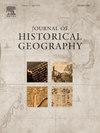使用第一张地籍图系统记录森林:布鲁莫夫庄园案例研究(捷克共和国)
IF 1.1
2区 历史学
Q2 GEOGRAPHY
引用次数: 0
摘要
本研究考察了捷克共和国前布鲁莫夫庄园系统记录森林的第一批地籍地图的使用情况。稳定地籍,最初用于税收效率,提供了一个独特的洞察前工业景观。利用基于gis的数字化技术,对9946公顷的1361个森林地块进行了分析,并与森林的现状进行了空间比较。该研究从所有权、树种组成和林龄方面考察了历史森林结构,揭示了两个世纪以来社会经济变化和造林实践变化所伴随的变化。结果表明,森林覆盖率从1828年的25.3%增加到今天的45%,这主要是由于从畜牧业转向造林趋势的增加;在组成上的转变也显示了从落叶树到针叶林的转变。本文及其附录旨在为历史制图数据在地理空间分析中的应用提供一个方法论蓝图,对历史学家、自然资源保护主义者和森林管理者都很有用。本文章由计算机程序翻译,如有差异,请以英文原文为准。
Systematic forest recording using the first cadastral maps: The Brumov estate case study (Czech Republic)
This study examines the use of the first cadastral maps for a systematic recording of forests in the former Brumov estate, Czech Republic. The Stable Cadastre, which was originally used for taxation efficiency, provides a unique insight into the pre-industrial landscape. Using GIS-based digitization, an analysis of 1361 forest parcels on 9946 ha was performed, allowing for spatial comparison with the current state of forests. The study examines historical forest structure with regard to ownership, tree species composition, and age of stands, revealing shifts accompanying socio-economic changes and changes in sylvicultural practices over two centuries. The results show an increase in forest coverage from 25.3% (in 1828) to 45% today, mostly due to the shift away from pastoral farming and an increase in afforestation tendencies; the transformation in composition also shows a shift away from deciduous trees to coniferous stands. The article and its appendix aim to provide a methodological blueprint for utilizing historical cartographic data in geospatial analyses – useful for historians, conservationists, and forest managers.
求助全文
通过发布文献求助,成功后即可免费获取论文全文。
去求助
来源期刊

Journal of Historical Geography
Multiple-
CiteScore
1.50
自引率
10.00%
发文量
53
期刊介绍:
A well-established international quarterly, the Journal of Historical Geography publishes articles on all aspects of historical geography and cognate fields, including environmental history. As well as publishing original research papers of interest to a wide international and interdisciplinary readership, the journal encourages lively discussion of methodological and conceptual issues and debates over new challenges facing researchers in the field. Each issue includes a substantial book review section.
 求助内容:
求助内容: 应助结果提醒方式:
应助结果提醒方式:


